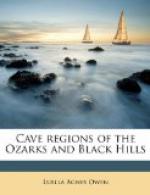The only forms of life ever found in Wind Cave are a small fly and the mountain rat.
While visiting the cave, every one connected with it was most kind and obliging, especially in showing those beautiful and difficult portions that few visitors are so fortunate as to see. While this is very far from being a complete description even of the parts visited, it will serve to show what a truly grand cavern is located at the south end of the Black Hills.
The elevation at Hot Springs is three thousand, four hundred feet, and that of the entrance to the cave is four thousand and forty feet. A source of disappointment in connection with Wind Cave is that its fine scenery cannot be effectively pictured.
CHAPTER XIII.
The onyx caves.
Northwest of Hot Springs there is a group of three onyx caves, the distance to them being estimated at from seven to ten miles, if the party does not get lost, which is the usual fate of those who dispense with the service of a driver familiar with the country. In going, the longer way, over the hill-tops, claims a preference on account of distant views with a favorable light. When the Onyx Cave Ranch is reached its scenery is found to be charming, with an ideal log house overlooking the canon, and itself overlooked by the rising slope of the wooded hill. The entrance to the cave is in the opposite wall of the canon, and is covered by a small cabin, at the door of which the view demands a pause for admiration; then the party disappears down a narrow, rough, sloping passage of sufficient height for comfort to none but know the value of comparative degrees. It soon appeared, however, that personal comfort would travel only a short distance. The mud increased with every step, and in its midst was a small hole through which it was necessary to pass to the next lower level. This hole being so small and its walls slanting, the only way to accomplish the first half of the descent was to sit down in the mud and slide, stopping half way to examine a fine ledge of beautiful striped onyx, white and a brownish pink, the first outcrop in the cave, but in the next level it is seen in rich abundance and variety; the colors being red, black and white, brown in several shades and pure white. All are handsome and of commercial quality and hardness; and just above them is a ledge of fine blue marble.
The next chamber is called the Bad Lands, on account of a certain resemblance to that desolate region. The way into it is through the Devil’s Corkscrew, a most uninviting passage because it stands on end and is about twelve feet deep with circular, perpendicular walls discouragingly free of prominent irregularities; but careful study reveals a few available crags and rough edges, by which the descent is made. Fortunately the party decreased in size just within the entrance. Climbing up into a hole in the wall of this room, with no little difficulty, the Aerial Lake is the reward of a breathless upward struggle, and a satisfying one. The Lake is very small, but under its clear surface can be seen numerous growing deposits of calcite, while the roof of onyx gleams with a mass of small white stalactites.




